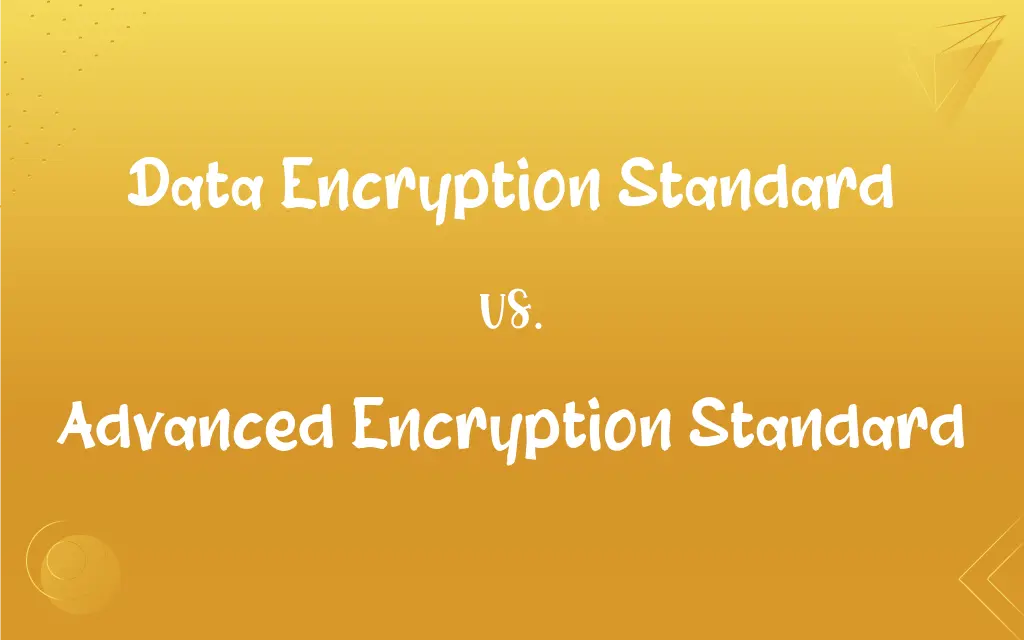Data Encryption Standard vs. Advanced Encryption Standard: What's the Difference?
Edited by Aimie Carlson || By Janet White || Published on February 27, 2024
Data Encryption Standard (DES) is an older, 56-bit key cipher, less secure than Advanced Encryption Standard (AES), a more modern, 128-256 bit key cipher, offering enhanced security.

Key Differences
Data Encryption Standard (DES) and Advanced Encryption Standard (AES) are both symmetric key encryption algorithms. DES, developed in the 1970s, uses a 56-bit key, making it less secure against brute-force attacks. AES, introduced in 2001, uses key sizes of 128, 192, or 256 bits, offering significantly stronger security.
DES was widely adopted for encryption due to its simplicity and effectiveness in its time. However, with advances in computing power, its 56-bit key size became vulnerable. AES, on the other hand, was designed to replace DES, addressing its key size limitations and improving resistance to various attack techniques.
Data Encryption Standard involves a complex series of permutations and substitutions, but due to its shorter key length, it's susceptible to modern computational attacks. Advanced Encryption Standard, with its longer key lengths, provides a more robust security framework, making it suitable for government and industry use.
DES operates in various modes, but each has limitations due to the inherent 56-bit key structure. AES not only offers a longer key size but also operates efficiently in different modes, providing flexibility and enhanced security for diverse applications.
In DES, the encryption process is relatively faster on older and less powerful hardware. However, AES is optimized for modern processors, offering fast and secure encryption even on devices like smartphones, making it a better choice for current technology needs.
ADVERTISEMENT
Comparison Chart
Full Form
Stands for "Data Encryption Standard"
Stands for "Advanced Encryption Standard"
Key Length
Utilizes a 56-bit key
Employs keys of 128, 192, or 256 bits
Security Level
Considered less secure due to shorter key
Highly secure due to longer key options
Introduction Era
Introduced in the 1970s
Introduced in the early 2000s
Usage Context
Was a standard for encryption, now mostly obsolete
Currently the standard for secure encryption
ADVERTISEMENT
Data Encryption Standard and Advanced Encryption Standard Definitions
Data Encryption Standard
DES operates through 16 rounds of permutation and substitution.
Each round of DES altered the data bit by bit.
Advanced Encryption Standard
AES replaced DES due to its enhanced security features.
After switching to AES, their data breaches significantly reduced.
Data Encryption Standard
DES's 56-bit key makes it vulnerable to brute-force attacks.
Their security was compromised when hackers broke the DES encryption.
Advanced Encryption Standard
AES is efficient in both hardware and software environments.
AES's versatility makes it ideal for diverse technological applications.
Data Encryption Standard
DES was once the standard for data security.
Banks often relied on DES for securing transactions.
Advanced Encryption Standard
AES is a widely used encryption standard with variable key lengths.
AES secures our emails with its robust encryption method.
Data Encryption Standard
DES is a symmetric-key algorithm for encrypting electronic data.
They used DES to encrypt their files in the 1990s.
Advanced Encryption Standard
AES can use 128, 192, or 256-bit keys for encryption.
They chose 256-bit AES for maximum security.
Data Encryption Standard
DES uses a single key for both encryption and decryption.
The same key was used for both locking and unlocking the data in DES.
Advanced Encryption Standard
AES's structure is based on the Rijndael cipher.
AES, derived from Rijndael, offers advanced data protection.
FAQs
What is DES?
DES is an encryption standard that uses a 56-bit key for encrypting data.
Why is AES more secure than DES?
AES offers key sizes of 128, 192, or 256 bits, providing stronger security than DES's 56-bit key.
How fast is AES compared to DES?
AES is generally faster and more efficient, especially on modern hardware.
Can AES keys be easily cracked?
Due to its long key lengths, AES is highly resistant to brute-force attacks.
Why was DES replaced by AES?
DES was replaced due to vulnerabilities in its shorter key length and susceptibility to modern attacks.
How is AES implemented in software?
AES can be implemented in various programming languages and is supported by many cryptographic libraries.
Are there any known vulnerabilities in AES?
As of now, no practical vulnerabilities have been found in AES.
Was DES ever considered secure?
Yes, in its time, DES was considered a secure encryption standard.
Is DES still used today?
DES is largely obsolete and has been replaced by more secure standards like AES.
What makes AES preferable over DES?
AES's longer key lengths and resistance to various attack techniques make it preferable.
Is AES suitable for all types of data encryption?
Yes, AES is versatile and suitable for a wide range of encryption needs.
How does key size affect AES encryption?
Larger key sizes in AES offer increased security but may require more processing power.
Is DES encryption easy to implement?
DES is relatively simple to implement but is not recommended due to security concerns.
What industries use AES for encryption?
AES is used across various industries, including finance, government, and healthcare.
Can AES be used for encrypting large volumes of data?
Yes, AES is efficient and scalable for encrypting large volumes of data.
How often should AES keys be changed?
Regular key changes are recommended, depending on the sensitivity of the data.
What are the modes of operation in DES?
DES can operate in several modes, including ECB, CBC, CFB, and OFB.
Is it easy to switch from DES to AES?
The transition requires changes in encryption software and policies but is manageable.
Does AES encryption slow down systems?
AES is designed to be efficient and typically does not significantly slow down systems.
What is the primary advantage of AES over DES?
The primary advantage is AES's enhanced security through longer key lengths.
About Author
Written by
Janet WhiteJanet White has been an esteemed writer and blogger for Difference Wiki. Holding a Master's degree in Science and Medical Journalism from the prestigious Boston University, she has consistently demonstrated her expertise and passion for her field. When she's not immersed in her work, Janet relishes her time exercising, delving into a good book, and cherishing moments with friends and family.
Edited by
Aimie CarlsonAimie Carlson, holding a master's degree in English literature, is a fervent English language enthusiast. She lends her writing talents to Difference Wiki, a prominent website that specializes in comparisons, offering readers insightful analyses that both captivate and inform.
































































